Massasoit had two sons, Metacomet and Wamsutta. The colonists came to call them Philip and Alexander, after Philip of Macedon and Alexander the Great. The boys grew up at a time when the number of settlers was rising dramatically—along with the number of abuses against Indians. Unlike their father, Massasoit, they became militant, believing it was necessary to make a stand to protect their way of life.
The new generation of Wampanoag resented the fact that when an Indian committed a crime under English law, he was taken before a colonial court to be tried -- -
Wampanoag warclub, supposedly belonging to King Philip
Rather than before his own people. After one such incident, Wamsutta, who had succeeded Massasoit as grand sachem, died during the trip home. Metacomet, now grand sachem, believed that the colonial officials had poisoned his brother and wanted revenge. He also wanted the Wampanoag to regain their former greatness.
Metacomet took his time, sending runners to other tribes to ask their help. His goal was to organize an alliance of tribes that would be strong enough to oust all colonists from New England. He was the first great Native American leader to envision and work toward such an alliance of tribes. NARRAGANSETT and NIPMUC bands offered their support.
Colonial officials sensed the growing militancy and tried to harass Metacomet, calling him before a court and ordering the Wampanoag to turn in their flintlocks. Metacomet yielded to their demands in order to buy more time, relinquishing some but not all of the Wampanoag guns. Even so, fighting came prematurely. In June 1675, the colonists arrested and hanged three Wampanoag accused of killing a Christianized Indian. In the increased state of tension, fighting broke out near the Wampanoag village of Mount Hope. A settler fired at and wounded a tribal member in an argument over cattle. The Wampanoag retaliated, killing 11 colonists. King Philip’s War had begun.
After these opening hostilities, the allied tribes— Wampanoag, Narragansett, and Nipmuc—began a campaign of violence against the settlers. Small war parties attacked outlying settlements all over New England, from the Connecticut River to the Atlantic Coast.
The New England Confederation of Colonies, including Massachusetts Bay, Plymouth, Rhode Island, and Connecticut, mustered armies. Awashonks, the woman sachem of the Sakonnet, part of the Wampanoag Confederacy, eventually gave her support to the colonists. They engaged the Indians in several major battles. The first occurred in July at Pocasset Swamp, in Wampanoag territory. The next two occurred the following autumn along the northern Connecticut River valley in Nipmuc country—at Bloody Brook and Hopewell Swamp. The deciding battle took place in Narragansett territory—the Great Swamp Fight of December 1675. The Narragansett lost more than 600 men, women, and children.
There were two more major encounters and colonial victories, one near Deerfield, Massachusetts, and the other near Plymouth, the latter known as the Bridgewater Swamp Fight. Soon afterward, Metacomet was betrayed by an Indian informer and killed at Mount Hope. His killers cut up his body and kept the parts as trophies.
In the aftermath of King Philip’s War, Metacomet’s wife and son were shipped to the Caribbean to be sold as slaves for 30 shillings apiece. The colonists took their revenge on peaceful tribes as well, seizing more and more Indian territory. Some Wampanoag did manage to retain their lands, in particular those on the islands of Martha’s Vineyard and Nantucket, who stayed out of the conflict. European diseases continued to take their toll over the years, further reducing the Wampanoag population. But even as the number of non-Indians grew exponentially around them, the Wampanoag endured.




 World History
World History









